We drove straight from Paro to the capital, Thimpu, yesterday. It’s about a 90 minute drive. Why is the airport not near the capital city? Because Thimpu is in an even more diabolical aviation-unfriendly valley than Paro!
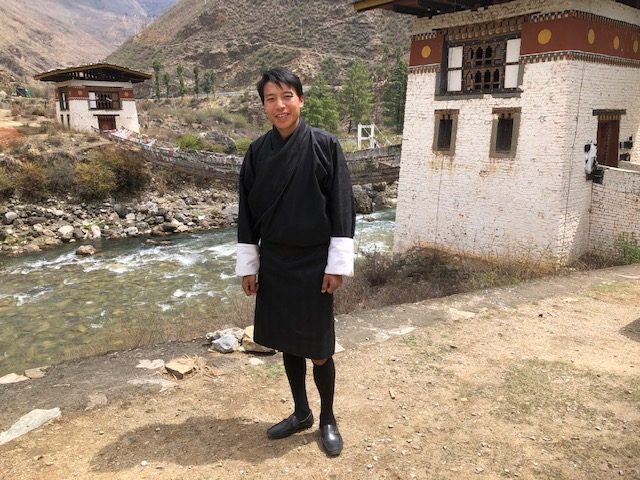
‘We’ is me, guide Karma (great name for a Buddhist, eh?) and driver Wongchuk who speaks English, at least to the extent that he understands everything I say, but it’s a bit more problematic in the other direction.
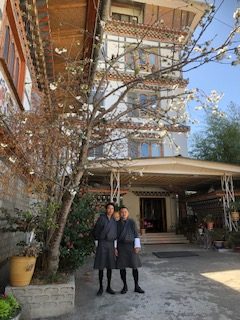
For some reason Wongchuk was assigned to dine with me at lunch yesterday while Karma ….did something else. He had a typical polite reserve about him and it fell to me to ask all the questions. I ascertained that all schooling in Bhutan is conducted in English from the start. It’s free, as is health care, but you can pay more for private services.
We also discussed dogs. There is a big population of them coming from the days when they were farm or hunting animals. Now they hang around the cities in loose packs. By day they loll around like this, but by night they fight and bark and howl something shocking.
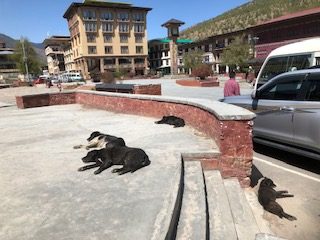
Wongchuk was surprised to learn that in Australia there are no stray dogs. Theirs is a very different relationship with Man’s Best Friend. No one owns them but somehow they get fed. They are not affectionate and don’t seek human company but neither are they savage, despite the bloodcurdling howling and yelping that plagues you at night.
Well it certainly plagues me, and has plagued other tourists. I know because I read about it online while reading up on Bhutan. Whereupon my heart sank and I dearly wished I could cancel the trip because I simply cannot sleep through the barking of dogs.
But there are nocturnal hours when even the dogs sleep so with the help of earplugs and pharmaceuticals I’ve sort of managed.
I don’t know how the locals cope with the barking but the government has tried some interesting management techniques. First they tried poisoning the strays, but this didn’t sit well with the Buddhist principles of the people. Then they tried rounding them up into enclosures but the dogs and the people hated this too. Now, according to Karma, the government has a program of sterilisation, with the dogs allowed to roam freely but hopefully not to breed. He gave a skeptical laugh which suggested the authorities might not be pursuing this course with much diligence or success.
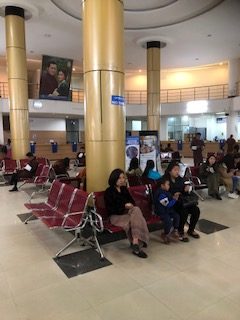
Speaking of authorities, you probably know the story of how back in the late nineties the then King of Bhutan decreed that a) the country’s main priority would be Gross National Happiness rather than Gross National Product and b) that he would renounce royal power for himself and his heirs and establish democracy. And he did! It’s a kind of constitutional monarchy now which holds elections (which Karma says they found a bit puzzling at first) and the royal family are a bit like the British royals in that as heads of state they are basically high-ranking civil servants. But they are more hands-on than the Brits, and do have a lot of power, mainly because they are so loved and respected.
The present king, the one in the portrait in the bank here, is the son of the one who made those decisive moves for Bhutan’s future. Fun fact about him: Bhutanese Buddhism is not traditionally polygamous but that king had four wives. First he had one, then he married three sisters. Those sisters had an older sister but for some reason he didn’t include her in the bridal party. When he made the big announcement about GNH and abdication, he also announced that henceforth his heirs would only have one wife. So having set himself up nicely he decrees that henceforth polygamy’s out and the country’s going mainstream. But nobody seems to mind. His son, the present king, is married to a woman ten years younger. Just sayin’.
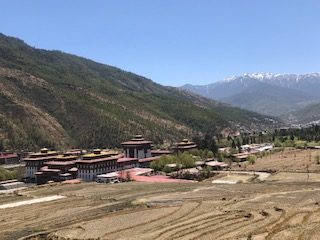
I suppose it’s easier to establish harmonious governance in a country that is so culturally, ethnically and religiously homogeneous. The population is only 800,000, and the government is determined that it not be swamped by immigration. It’s not mentioned in polite circles here but some years ago Bhutan expelled a few thousand ethnically Nepalese people – I saw a refugee camp in Nepal housing them. Bhutan is overwhelmingly Buddhist, and those refugees may well have been Hindu as well as ethnically Nepalese, ie more like Indian people whereas the Bhutanese are closer to Tibetans.
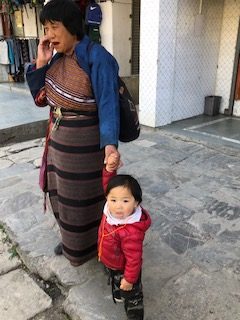
And they overwhelmingly still wear national costume. Karma said ‘we wear it for work’, and indeed all the guides and drivers and people in banks and hotels are all in traditional dress, but so are most of the people I saw on the street when I was set free to wander the main street of Thimpu alone.
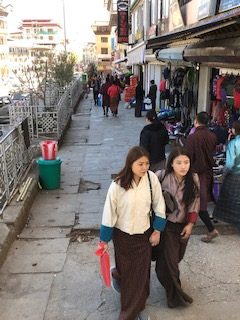
Tourism is strictly regulated and it’s not possible to enter the country as a solo traveller. You have to be accompanied by an authorised Bhutanese guide, but they do let you wander about a bit, as above.
Thimpu, the capital, has only 180,000 people – only a bit smaller than Hobart. It’s a bit like Nepal in that there is furious building going on seemingly everywhere, but there is notably less rubbish. More on that later, and on cars and money and suchlike. But Karma and Wongchuk will be here soon to collect me. We’re driving over a 3000m+ mountain ridge to a place called Punakha. Meanwhile here’s a farewell shot of me having a go at the national sport, archery. I missed.

Here I am talking to Paul McIntyre on ABC radio in Tasmania:
